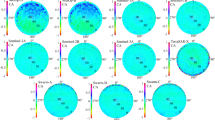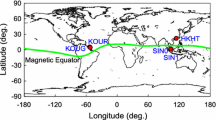Abstract
GNSS radio occultation (RO) plays an important role in ionospheric electron density inversion. As China's first seismo-electromagnetic satellite, China Seismo Electromagnetic Satellite (CSES) has collected the RO data with both GPS and BDS-2 satellites since March 2018. We analyzed the data quality of CSES GNSS occultation receiver (GOR) with almost one year of data in terms of signal-to-noise ratio, the cubic difference between epochs and the MP (multipath) combination. It was found that at the start of the signal acquisition, the GPS signal of GOR is affected to abnormal jumps on both P1 and P2 and large variations on P2, while the CSES BDS-2 GOR observation performed much better. To avoid potential contamination by these abnormal GPS observations in the CSES GOR ionospheric inversion, a quality control algorithm was promoted based on the MP2 combination. By removing the outliers using the quality control algorithm, the P2 observation integrity rate was 77.8% and 98.9% for GPS and BDS, respectively, and the abnormal values in the electron density profile can be detected and removed in the RO inversion efficiently. Then the comparison of F2 peak density and peak height was performed with respect to COSMIC for the whole experimental period with four different space–time matching criteria. The results of CSES GPS and BDS-2 suggested a significant correlation with that of COSMIC.












Similar content being viewed by others
Data availability
The COSMIC Radio Occultation data can be downloaded from https://cdaac-www.cosmic.ucar.edu/. The CSES Radio Occultation data can be obtained from http://www.leos.ac.cn and email author Shengfeng Gu.
References
Ambrosi G et al (2018) The HEPD particle detector of the CSES satellite mission for investigating seismo-associated perturbations of the Van Allen belts. Sci China Technol Sci 61:643–652. https://doi.org/10.1007/s11431-018-9234-9
Anthes RA et al (2008) The COSMIC/FORMOSAT-3 Mission: Early Results. B Am Meteorol Soc 89:313–334. https://doi.org/10.1175/bams-89-3-313
Bai W et al (2018) Evaluation of atmospheric profiles derived from single- and zero-difference excess phase processing of Bei-Dou radio occultation data from the FY-3C GNOS mission. Atmos Meas Tech 11:819–833. https://doi.org/10.5194/amt-11-819-2018
Cai Y et al (2017) In-orbit performance of GNOS on-board FY3-C and the enhancements for FY3-D satellite. Adv Space Res 60:2812–2821. https://doi.org/10.1016/j.asr.2017.05.001
Cheng Y, Lin J, Shen XH, Wan X, Li XX, Wang WJ (2018) Analysis of GNSS radio occultation data from satellite ZH01. Earth Planet. Phys. 2(6):499–504. https://doi.org/10.26464/epp2018048
Gómez-Casco D, López-Salcedo J-G, G, (2018) C/N0 estimators for high-sensitivity snapshot GNSS receivers. GPS Solut 22:122. https://doi.org/10.1007/s10291-018-0786-y
Gu S, Wang Y, Zhao Q, Zheng F, Gong X (2020) BDS-3 differential code bias estimation with undifferenced uncombined model based on triple-frequency observation. J Geod. https://doi.org/10.1007/s00190-020-01364-w
Gu S, Dai C, Fang W, Zheng F, Wang Y, Zhang Q (2021) Multi-GNSS PPP/INS tightly coupled integration with atmospheric augmentation and its application in urban vehicle navigation. J Geod 95(6):1–15. https://doi.org/10.1007/s00190-021-01514-8
Hajj GA, Lee LC, Pi X, Romans LJ, Schreiner WS, Straus PR, Wang C (2000) (2000) COSMIC GPS ionospheric sensing and space weather. Terr Atmos Ocean Sci 11:235–272. https://doi.org/10.3319/TAO.2000.11.1.235(COSMIC)
Hocke K, Igarashi K (2002) Structure of the Earth’s lower ionosphere observed by GPS/MET radio occultation. J Geophys Res. https://doi.org/10.1029/2001JA900158
Huang JP, Lei JG, Li SX, Zeren ZM, Li C, Zhu XH, Yu WH (2018) The Electric Field Detector (EFD) onboard the ZH-1 satellite and first observational results. Earth Planet. Phys. 2(6):469–478. https://doi.org/10.26464/epp2018045
Kliore AJ, Cain DL, Levy GS, Eshelman VR, Fjeldbo G, Drake FD (1965) Occultation experiment: results of the first direct measurement of Mars’ atmosphere and ionosphere. Science 149:1243–1248. https://doi.org/10.1126/science.149.3689.1243
Lei J et al (2007) Comparison of COSMIC ionospheric measurements with ground-based observations and model predictions: Preliminary results. J Geophys Res 112:A07308. https://doi.org/10.1029/2006JA012240
Lin J, Shen X, Hu L, Wang L, Zhu F (2018) CSES GNSS ionospheric inversion technique, validation and error analysis. Sci China Tech Sci 61:669–677. https://doi.org/10.1007/s11431-018-9245-6
Lomidze L, Knudsen DJ, Burchill J, Kouznetsov A, Buchert SC (2017) Calibration and Validation of Swarm Plasma Densities and Electron Temperatures Using Ground-Based Radars and Satellite Radio Occultation Measurements. Radio Sci 53:15–36. https://doi.org/10.1002/2017rs006415
Lou Y et al (2019) Two Typical Ionospheric Irregularities Associated With the Tropical Cyclones Tembin (2012) and Hagibis (2014). J Geophys Res Space Physics 124(7):6237–6252. https://doi.org/10.1029/2019JA026861
Luo J, Wang H, Xu X, Sun F (2019) The Influence of the Spatial and Temporal Collocation Windows on the Comparisons of the Ionospheric Characteristic Parameters Derived from COSMIC Radio Occultation and Digisondes. Adv Space Res 63:3088–3101. https://doi.org/10.1016/j.asr.2019.01.024
Luo X, Gu S, Lou Y, Cai L, Liu Z (2020) Amplitude scintillation index derived from C / N 0 measurements released by common geodetic GNSS receivers operating at 1 Hz. J Geod 94(2):1–14. https://doi.org/10.1007/s00190-020-01359-7
Luo X, Lou Y, Gu S, Li G, Xiong C, Song W, Zhao Z (2021) Local ionospheric plasma bubble revealed by BDS Geostationary Earth Orbit satellite observations. GPS Solut. 25(3):1–10. https://doi.org/10.1007/s10291-021-01155-6
McNamara LF, Thompson DC (2015) Validation of COSMIC values of foF2 and M(3000)F2 using ground-based ionosondes. Adv Space Res 55(1):163–169. https://doi.org/10.1016/j.asr.2014.07.015
Schreiner WS, Sokolovskiy SV, Rocken C, Hunt DC (1999) Analysis and validation of GPS/MET radio occultation data in the ionosphere. Radio Sci 34(4):949–966. https://doi.org/10.1029/1999RS900034
Shen XH, Zong Q-G, Zhang XM (2018) Introduction to special section on the China Seismo-Electromagnetic Satellite and initial results. Earth Planet. Phys. 2(6):439–443. https://doi.org/10.26464/epp2018041
Shi C, Guo S, Gu S, Yang X, Gong X, Deng Z, Ge M, Schuh H (2019) Multi-GNSS satellite clock estimation constrained with oscillator noise model in the existence of data discontinuity. J Geod 93(4):515–528. https://doi.org/10.1007/s00190-018-1178-3
Shim JS, Scherliess L, Schunk RW, Thompson DC (2008) Spatial correlations of day-to-day ionospheric total electron content variability obtained from ground-based GPS. J Geophys Res 113:A09309. https://doi.org/10.1029/2007JA012635
Sun Y et al (2018) The FengYun-3C radio occultation sounder GNOS: a review of the mission and its early results and science applications. Atmos Meas Tech 11:5797–5811. https://doi.org/10.5194/amt-11-5797-2018
Teunissen PJG, Montenbruck O (2017) Springer handbook of global navigation satellite systems. Springer, Cham
Tsai LC, Liu CH, Hsiao TY (2009) Profiling of ionospheric electron density based on FormoSat-3/COSMIC data: Results from the intense observation period experiment. Terr Atmos Ocean Sci 20:181–191. https://doi.org/10.3319/TAO.2007.12.19.01(F3C)
Tsai LC, Cheng KCL, C.H, (2011) GPS radio occultation measurements on ionospheric electron density from low Earth orbit. J Geod 85:941–948. https://doi.org/10.1007/s00190-011-0476-9
Wang K, Tam SWY (2010) Analysis of ionospheric electron parameters versus geomagnetic index Dst from RO data of FORMOSAT-3/COSMIC. GPS Solut 14:99–108. https://doi.org/10.1007/s10291-009-0148-x
Wang X, Cheng W, Zhou Z, Xu S, Yang D, Cui J (2019) Comparison of CSES ionospheric RO data with COSMIC measurements. Ann Geophys 37(6):1025–1038. https://doi.org/10.5194/angeo-37-1025-2019
Wang X, Yang D, Liu D, Zhou Z, Cheng W, Xu S, Guo F (2020) Validation of CSES RO measurements using ionosonde and ISR observations. Adv Space Res 66:2275–2288. https://doi.org/10.1016/j.asr.2020.08.028
Wanninger L, Beer S (2015) BeiDou satellite-induced code pseudorange variations: diagnosis and therapy. GPS Solut 19:639–648. https://doi.org/10.1007/s10291-014-0423-3
Yan R, Guan YB, Shen XH, Huang JP, Zhang XM, Liu C, Liu DP (2018) The Langmuir Probe onboard CSES: data inversion analysis method and first results. Earth Planet. Phys. 2(6):479–488. https://doi.org/10.26464/epp2018046
Yang YX, Mao Y, Sun BJ (2020) Basic performance and future developments of BeiDou global navigation satellite system. Satell Navig 1:1. https://doi.org/10.1186/s43020-019-0006-0
Zhao Q, Wang Y, Gu S, Zheng F, Shi C, Ge M, Schuh H (2019) Refining ionospheric delay modeling for undifferenced and uncombined GNSS data processing. J Geod 93(4):545–560. https://doi.org/10.1007/s00190-018-1180-9
Acknowledgements
COSMIC Radio Occultation data can be downloaded from https://cdaac-www.cosmic.ucar.edu/, CSES Radio Occultation data can be downloaded from http://www.leos.ac.cn. The authors express their thanks. This research has been supported by the National Key R&D Program of China (grant no. 2018YFC1503502), the National Natural Science Foundation of China (No. 42104029), the China Postdoctoral Science Foundation (No. 2021M692975) and the Specialized Research Fund for Key Laboratory of Earth and Planetary Physics (No. DQXX2021-11).
Author information
Authors and Affiliations
Corresponding author
Additional information
Publisher's Note
Springer Nature remains neutral with regard to jurisdictional claims in published maps and institutional affiliations.
Rights and permissions
About this article
Cite this article
Gu, S., Gan, C., Qing, Y. et al. Statistical study on the CSES radio occultation data and its quality control in electron density inversion. GPS Solut 26, 95 (2022). https://doi.org/10.1007/s10291-022-01282-8
Received:
Accepted:
Published:
DOI: https://doi.org/10.1007/s10291-022-01282-8




